|
Obsolete Outboards |

|
|
by Max Wawrzyniak - St Louis, Missouri - USA
Odds & Ends |
 |
This month's column is a hodge-podge of comments and updates.
Propellers
Back in the propellers column I mentioned that used propellers can often be found at swap meets and flea markets
but that it can sometimes be difficult to identify exactly which outboards they fit.
Outboard props, unlike inboard props, are rarely marked with diameter and pitch, and
are never marked with which outboards they fit. Both OEM and aftermarket propellers
are usually marked with only a part number.
The most commmonly seen aftermarket props are made by Michigan Wheel Corp. In fact,
one will usually see more Michigans than OMC props. Since before World War II Michigan
Wheel has published catalogs of their outboard motor propellers and copies of these catalogs
are usually not too difficult to get. The problem is the way the catalogs are arranged; one looks
up the model engine and then is presented with the part numbers of the props that fit that
engine. However, there is no "reverse" directory which allows one to look up a specific prop
number to see which engines it fits. If one finds a likely looking prop at a swap meet, the drill is
to scan the columns of prop part numbers in the catalogs (which numbers are not issued in any apparent
logical order) to see if by chance you can locate the prop and reference which engines it fits.
I have personally telephoned Michigan Wheel and have verified that there is no reverse
directory available. So for years I have scanned the columns of prop numbers to identify
what prop I had in my hand.
My buddy Arnold, a fellow outboard collector and retired computer guy, was a little more ambitious.
Utilizing a spreadsheet program and the old Michigan Wheel catalogs, Arnold has created a
reverse directory which allows one to look up props by their part numbers, which usually consist
of 2 or 3 letters and 3 numbers ( AB123, ABC 123, etc.). Arnold's guide covers Michigan props
for all brands of outboards, not just the old OMC engines I hold so dear.
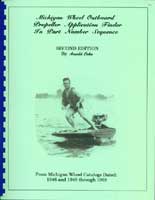 |
Figure 01
The second edition lists Michigan Wheel Corp. outboard motor
propellers in alpha-numeric part number sequence.
(click images for larger views) |
|
For the guy who goes prop hunting at outboard motor swap meets, Arnold's propeller guide can be
an invaluable resource, and he is printing and selling copies of it in three flavors. One can buy the
reverse directory, with the props arranged in alpha-numeric order (figure 01); or one can buy a prop guide
organized by motor model (figure 02); or one can buy a combined version of both guides. Prices incuding delivery
within the USA for the individual guides are $18.00 each, or $35.00 delivered for the combined version.
Figure 02
The first edition lists propellers by motor brand and model sequence. |
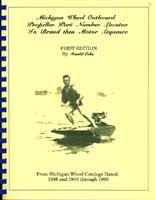
|
|
Arnold can be reached for additonal info at arnoldcohn@charter.net In the interest of full disclosure
I should mention that Arnold is paying me $50,000.00 cash to promote his book. And if you believe
that, I also have a good used car I would like to sell you. Actually, I have no financial interest in
the book. I have known Arnold for over 10 years and he is an honest person and a heck of a nice
guy and he has created a very useful reference for those of us who are either too darn cheap to
buy new propellers for our old outboards, or who own an old outboard for which no new props
are available.
Lower Unit Lubricant
In the columns on lower units
I mentioned the use of Lubriplate #105 white grease as a substitute lower unit lubricant instead of oil
(figure 03). Being thicker (I think the proper term is more viscous) than lower unit oil, the lubriplate grease
will almost never leak out even if the seals in the lower unit are less than perfect. This means one
does not need to worry about one's lower unit ending up full of water instead of oil, and one can be
less concerned about leaking oil into the waters of our earth.
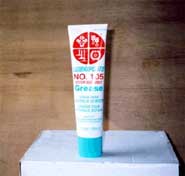 |
Figure 03
Lubriplate #105 white grease is available at good auto parts stores. In
addition to its use in outboard motors, #105 is also used by automotive
engine rebuilders.
|
|
Lubriplate only recommends the use of their #105 grease in non-shift lower units; i.e. lower units with no
forward-neutral-reverse gearshift. But I have seen it used in shift lower units before. At a recent outboard
motor swap meet I had the opportunity to talk with a retired Mercury outboard
motor mechanic who is also a collector of antique outboards, and he saw no problem with using Lubriplate
#105 white grease in shift lower units and had used it in same. Jim Michalak was also at the swap meet;
he has had Lubriplate in the lower unit of one of his outboards for a year and has experienced no problems.
I remain convinced that Lubriplate #105 is a viable alternative to normal lower unit oil, even for shift lower
units. Keep in mind that one must still occasionally drain accumulated water from the lower unit as the grease
will not prevent water from getting in; the grease just does not leak out. I would not substitute another white
grease for the Lubriplate # 105.
Fuel Pump News
In the Fuel Pump Conversion column
I explained how to convert an old OMC outboard to use a fuel pump instead of the pressurized fuel tank.
At the recent outboard swap meet I had to chance to look over a 1957 Evinrude 7 1/2 hp outboard
converted to use a fuel pump by a reader (figure 04). He pretty much followed the instructions as written except
that he used J B Weld instead of the hard-setting gasket cement that I used. The swap meet was held
on a small farm with a pond, and the converted engine made a few laps around the pond on an aluminum
boat.
Figure 04
A 1957 Evinrude 7 1/2 hp outboard converted to use a fuel pump by a
Duckworks reader. |
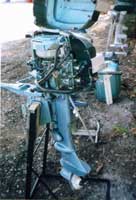
|
|
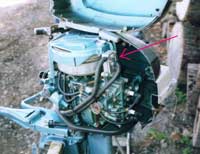 |
Figure 05
Fabricated metal strap brackets securely hold the fuel pump, but I would
not secure the brackets under cylinder head bolts, as I believe in disturbing
50 year-old head bolts as little as possible.
|
|
The installation was very nicely done ecept that one of the fabricated pump mounting brackets was
placed under a cylinder head bolt. I prefer to not disturb head bolts if possible: I have had too many of
them twist-off, and if the bolt is not re-torqued properly the head gasket could blow-out. Just my opinion,
and this particular installation apparently caused no problems (figure 05).
Happy Motor'n, ya'all

click here for a list of Columns by Max Wawrzyniak
|